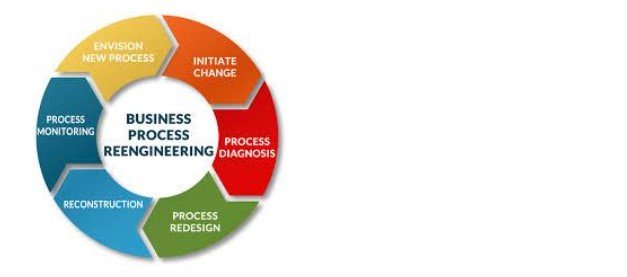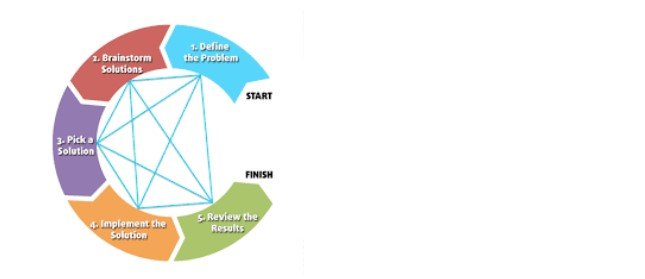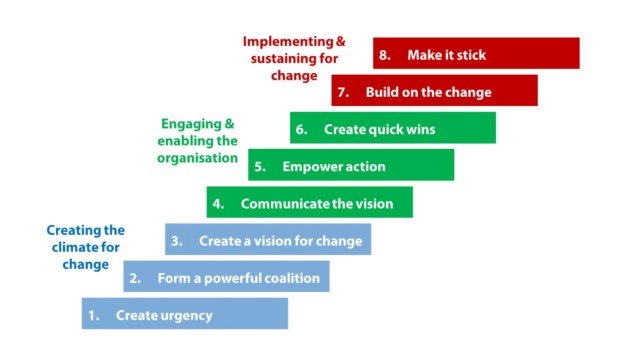Understand techniques and tools that support the design of business processes
Analysing the principles of business change and business process re-Engineering
Context
The principle of organisational change is related to leading the change initiatives through a systematic way and in this regard, Kotter’s eight stage model is effective to manage change and convince the employees to contribute efficiently for successful change management practice. On the other hand, the organisational principle of business re-engineering is different from change management where under the business re-engineering process the business process is changing accordingly, where the internal functions, the operational process and activities are changed and upgraded to achieve higher. In this way, the organisation conducts SWOT and PESTLE analysis for major strategic change so that it would be beneficial for leading the organisation successfully. For students seeking business dissertation help, guiding them in understanding all these principles and models effectively as they are related to the change management strategies that lie within organisations.

The business process re-engineering is hereby different to the change management practice where the leader also focus on changed initiatives through eight steps such as creating urgency, forming powerful coalition, creating vision of change, communication the vision, removing barriers or obstacles, certain short term wins, building on the change and anchoring the change by creating suitable corporate culture.

The price re-engineering includes identifying the organisational strengths and weaknesses, acknowledging the market condition, threat and future opportunities and utilising him resources and capabilities for better strategic planning.
Evaluate the concept and application of workflow patterns and usability testing
Workflow patterns are varying with different workplace according to the business process and activities. The workers are managed well under suitable workflow patterns, where the managers try to develop effective patterns to handle the workforce and lead them efficiently towards achieving future success. The major three workflow patterns are independent, sequential and interdependent/ networked. The independent workflow pattern considers the working activities where the individual is concerned about his or her own role and responsibility. There are no cooperative working activities and the employees are working on their own. On the other hand, the sequential workflow pattern is related to structured series of steps where the one activity leads to another and the steps occur immediately after one another. Interdependent networked workflow pattern is appropriate for developing the workplace, where the employees are cooperation and collaborating to work as a team. Among these three working matter, the sequential working and interdependent workflow patterns are fruitful for developing the workflow in the organisation. The interdependent workflow structure is the most suitable working pattern where the employees can share their knowledge and experience and communicate with each other for better team building and group working activities.
Continue your journey with our comprehensive guide to Wirelessly powered light bulb system Design.
Evaluating a range of modelling tools
The tools and techniques of business process further propose changed initiatives in the organisation, where the manager is able to analyse the business process through the modelling and identify creative solutions to fulfil the organisational visions. Brainstorming is the tools where the employees get the scope of identifying the creative solutions, analysing the existing organisational practice and developing good decision to achieve higher. The brainstorming tools further enhance employee’s performance through creativity and innovation when they try to utilise their capabilities and experience to make changed initiatives. The Critical path analysis is also another tool, where the project management activities are noting down for better management of the business process with timetable and cost structure. In this way, the cost benefit analysis is also appropriate for analysing the cost of newly changed operational process of the business and acknowledges the benefits of implementing new change or re-engineering process in the business. Fishbone analysis is also effective for identifying the cause and effects of the business process, which also align the business process of re-engineering and ensure high performance workflow in the workplace.
Analysing the factors to be taken into account when evaluating the effectiveness of business processes
There are certain factors that determine the effectiveness and efficiency of the business process and in the recent era of globalisation, the corporate firms are concerned about continuous improvement model through TQM, total quality management in order to run their business efficiently in the market and grab the market opportunities in near future. The integrated system of work in the workplace, organisational culture and communication practice are playing crucial role in improving effectiveness and efficiency of the business process. The human resource management strategy through managing health and safety of the workforce giving rewards and compensations, arranging training programs are also effective factors to enhance the performance of the workforce in long run. Additionally, the decision making behaviour practice through creativity and technological innovation, supervision quality, and monitoring process at the workplace also enhances the quality and efficiently of the business process. Customer centred service development technological up-gradation and the internal operational process through ERP or Enterprise Resource planning system are also important factors that enhance the organisational performance and efficiency in long run.
Evaluating the scope for business process improvement and constraints
In the recent era of globalisation, there are different scopes of business process which further influence the organisational leader to develop appropriate decision and mitigate the constraints in long run. The major business opportunities are such as benefits of operating in the market, technological advancement and ERP system which enhances the organisational operational activities, market expansion, business creativity, high return on investment and continuous improvement through communication and collaboration. The organisations try to mitigate the constraint including time, budget and resources through reallocating the organisational resources, developing budget plan and Gantt chart to progress in the project and make it successful within time. The continuous improvement activities also provide a scope to the business to restructure the operational functions, developing organisational culture with fairness and transparency management at the workplace, enhancing communication and collaboration which are mandatory or the organisations to run their business successfully in the market and fulfil the organisational objectives.
Generating ideas that meet defined business needs
It is necessary for the business leader to meet the needs of the organisations and make the company sustainable in the market for future. In this regard, it is necessary to have innovative ideas for making decision so that it would be possible for the firms to secure future sustainable development. Brainstorming with the colleagues is one of the effective ways to develop new ideas and skills set of the employees for better performance. For business process sustainability, it is also necessary to arrange research and development programs, where the major stakeholders conduct the organisational research for exploring new tactics of conducting the operations. On the other hand, the technological innovation and developing technical infrastructure of the firm are another major tactics through which it is possible to propose new alternative suggestions to the business, which would be creative to gain organisational values.
Testing a proposed process through a modelling exercise
The modelling techniques to develop the project planning is effective where the flow chart model is good for the project managers and employees to take active part in the project and conduct this with step by step process. The organisational leaders and project managers try to develop flowchart with the process where the initiatives of the project, implementation phases, technological execution and other employee’s activities are controlled in a systematic process. On the other hand, the critical at analysis is also effective to develop the modelling exercise and propose the process successfully.
Evaluating the feasibility and viability of a proposed process against agreed criteria
Through gathering authentic data and relevant information, it is possible for the business leader to develop the whole project, it is mandatory to manage feasibility and viability to progress in the process with the relevant database. The feasibility of the project should be managed through acknowledging the availability of the people, time, resources and tools, technology, which contributes in the project success. The human resource management as well as capital investment improves feasibility of the process, where the business is able to progress in the project and make it successful by reallocating the organisational resources, utilising them efficiently an improving the economies of scale. On the other hand, viability depends on the cost and resources. The resources need to be arranged before the project planning as well as the cost structure must be developed to arrange the financial resources so that the leader can bear the cost during the project process.
Establishing the degree of overlap between a proposed process and existing processes and systems.
The degree of overlap between the proposed process and existing processes and system may raise issues in managing change and the process of re-engineering. The major overlap includes the process of operating the organisational activities, leading the employees through changed initiative, maximising the re-engineering process through change and development of the technological activities. These are the major factors which overlap to each other while managing change in the workplace and the re-engineering process for achieving organisational vision. The major issues during this process overlap between the proposed process and existing processes and systems are such as internal conflicts, resistance to change, misunderstanding and non-cooperation, misleading the employees, lack of knowledge and skill developmental activities and poor communication which may deteriorate the efficiency of the organisation to lead the changed initiatives and manage the re-engineering process.
Resolving tensions between existing and proposed systems and processes
Resolving the tension during the existing and proposed systems and processes is the responsibility of the management team where they try to convince the employees and fulfil their commitments towards them so that the internal conflicts and other issues would be mitigated.

The Lewin’s change management model is utilised as a tool to lead changes efficiently in the organisation. The managers try to share the organisational vision, create urgency of change and let them understand about the need for change initiatives. The managers also share the benefits of change and restructure the performance related pay and incentives program for the employees to motivate them and lead them successfully. The managers also try to convince them, increase communication and internal collaboration as well as empower them in the change process so that they get involved and valued during the change initiatives.
Adhering to organisational policies and procedures, legal and ethical requirements when developing business processes
The legal policies and ethical practice further enhances the changed initiatives in the business, where the Human Rights Act 1998, Employment legislations, Minimum Wage Act 1948, Equality Act 2010, Health and Safety at Workplace Act 1974 and non-discrimination polices and practice are contributing factors which reshape the business process and create values for the employees. The internal organisational ethical practice includes managing transparency and accountability at the workplace, maintaining fair decisions making behaviour, empowerment of the staff members in the workplace, giving equal opportunity to each employee, maximising employee’s values and maintaining health and safety of the staff at the workplace. These policies and ethical practice are mandatory and for leading the staff members and adopting the changed initiatives in an ethical way.
Analysing valid information using techniques that are appropriate to the process being evaluated
Business data and information gathering is one of the effective way to note down and acknowledge the business issues, and identify the risk associated with the data and information so that the organisational leader can develop suitable tactics to mitigate the existing risks. The data and information gathering activity is effective here through the Crosby 5 step model, it is possible to analyse the data and evaluate it further better result.

In the regard, the five stages are identifying the existing problems, acknowledging the issues, generating hypothesis and prioritising them, conducting the analysis and advancing the answers with creativity and innovation. Apart from that, the accuracy and frequency of the risk factors are measured through the information and data analysis for restructuring the business process. In this regard, the statistical measures and charts, diagrams are also mandatory for representing the information and gathered data on the organisation so that data analysis and decision making practice would be easier. The chart and graphs are fruitful in this regard and it is easy for the stakeholders engaged with the business process to analyse the data and understand the organisational practice for better performance.
Assessing the cost and benefit of a business process to the organization
The cost benefit analysis is one of the important factors in developing the business process through re-engineering. The costs includes the human resource cost, financial cost, administrative and machineries, investment and research costs and other costs related to electricity and internal expenses., which need to be considered in the process of business re-engineering. During the implementation of business process, the cost of hiring the manpower is considered as the employees are the major stakeholders of the business to operate in the market. Additionally, the cost of equipment and raw materials purchase for the manufacturing activities are also necessary and apart from that the expenses to arrange the training and development program is also important to improve knowledge and technical skill of the staff so that they would be able to perform efficiently. Hereby, the administrative cost, recruitment and selection expenses, the cost associated with research, monitoring and supervision, training program, are also necessary to be included in the cost benefits analysis. The business leader aims at maximising Return on Investment (ROI) in order to provide high return on the investment of the stakeholders, so that the business process would be implemented efficiently and it would also be possible to maximise the organisational profitability and efficiency.

Justifying recommendations for the rejection, adoption or enhancements to processes with evidence
The designed change is mandatory for the business process of re-engineering to enhance the firm’s performance and adopt new creative solution and decision to make the business successful. Through the changed initiatives, it is also possible to increase creativity and technological innovation in running the operations of the organisation. It would be beneficial for the business to adopt new changes in the workplace and convince the employees to tale active art for achieving future success. For making business improvement, continuous development of the process re-engineering and achieving bottom line benefits would also be possible through designed change model, where the managers are responsible to handle the workforce and create values for them.

For implementing the designed change, the above tools of fish bone analysis, Kotter’s change management model as well as cost benefit analysis is executed in the business so that the major cause and effects would be analysed and the management team can empower the staff members for better organisational practice. The designed changed process can be implemented efficiently in the business through enhancing internal cooperation, partnership working practice, collaborative decision making behaviour and enhancing communication, where the managers can restructure the rewards and benefits for the employees to create values for them and motivate them to work with their capabilities.
Looking for further insights on Waitrose Codes of Conduct? Click here.
Dig deeper into To Assess the Current Practices which Could be used to Control the Cost Structure in the Catering Business with our selection of articles.
- 24/7 Customer Support
- 100% Customer Satisfaction
- No Privacy Violation
- Quick Services
- Subject Experts



